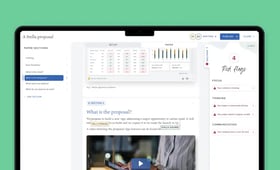A board portal is specialist governance software that provides safe and efficient delivery of digital board packs. Board portals offer a secure environment for board members and their organisation’s secretariat to access board and committee meeting materials, communicate with each other, and execute their governance responsibilities. And by replacing printing, couriering, and emailing, they simplify the board meeting cycle — enabling both directors and governance professionals to better focus on what matters.
Today, board portals are commonplace, be it in the boardrooms of FTSE 100s, SMEs, NHS trusts, colleges, or schools. But what should a board portal do? What should you expect from its provider? And at what point does it become worth the investment for your organisation? This guide answers those questions and more.
What features should a board portal offer?
A fully-fledged board portal should make it quick and easy for the company secretariat to compile and distribute packs and agendas; allow directors to access, read, and annotate their papers anytime, anywhere; and help report writers produce better reports. In other words: it should save company secretaries and directors time whilst also enhancing the quality and security of your board meetings and materials.
Look out for key features such as:
- Agenda planner — to organise your year ahead and measure where you spend your time.
- Briefing tool — automating the process of getting papers back from your report authors and enabling them to hit the mark.
- Stakeholder management tool — to check and evidence whether you meet your obligations under Section 172 of the UK Corporate Governance Code.
- Auto-save — ensuring you don’t lose any ongoing work.
- Drag-and-drop pack creation — for easy, quick changes.
- Notes and shareable annotations — to prep and collaborate before meetings.
- Robust search — to quickly look through all of your past board materials.
- Offline access — so that board members can prepare for meetings even when on the move.
- Intuitive design — enabling even the less tech-savvy board members to get started.
What should a board portal offer each stakeholder group?
For directors: easy, safe, on-the-go access
Directors expect their board portal to provide the simplicity of paper combined with the power of technology. For them, a good portal app should be intuitive to pick up, guarantee easy access to the most up-to-date information, and nail the basics around searching, reading, and annotating packs — because that’s the bulk of what they’ll use it for prior to their meetings.
But a great board portal is more than just a secure Kindle for NEDs. By creating a space to discuss and clarify what’s in the papers before the day, it should also give directors more time for deliberations and strategic discussions in their actual meetings.
For directors, the best board portals:
- Provide secure and instant access on the go, whether you are online or offline.
- Alert directors to new papers and updates.
- Allow directors to search their full archive of electronic board papers easily.
- Allow directors to make notes and retain those notes when a paper is updated — even if page numbers change.
- Provide 24/7 year-round support from actual humans — not chatbots.
For company secretaries: reduced administrative burden
The ultimate aim of a board portal is to make the pre-meeting activities more efficient in order for the meeting itself to be more effective. And so, company secretaries expect their portal to automate or speed up most of the administrative tasks so that they may spend time on areas where they can add the most value.
For them, a good portal should offer easy, drag-and-drop pack creation and agenda management — two features that, amongst others, can deliver time-savings of up to 80% when compiling and distributing a board pack. And whilst no board portal can stop report authors from making last-minute changes to their paper, the more sophisticated board portals will provide version control — ensuring that everyone is accessing the right information.
For the secretariat, the best board portals:
- Are fast and intuitive to use, saving time and relieving the administrative burden.
- Quickly publish packs, updates, and late papers.
- Can drag and drop agenda items, and recalculate timings and section numbers on the fly.
- Easily arrange files, of any format, with drag and drop.
- Give a simple way to control who sees which sensitive documents.
- Manage version control and keep track of your audit trail.
- Streamline the process of briefing report writers, deadlines, and feedback.
- Provide 24/7 support from trained in-house specialist support staff.
For report authors: clarity
A good board portal will remove the need for countless back-and-forth emails with your report writers, reducing both the burden on your inbox and the security risk of including sensitive attachments. It will also provide a platform to train your writers and drive the continual improvement of your board reports.
For report authors, the best board portals:
- Seamlessly manage briefings, task deadlines, and version control, all in one place.
- Provide an easy mechanism for feedback on papers between report writers and the company secretariat.
- Equip report writers with best-practice templates, guidance, and training for more effective reports.
For the IT team: assurance
IT teams have the important task of making sure the board has the right technology — and that it stays secure, too. Each organisation has its own criteria, and board portal providers should be happy to engage directly with your IT team to accommodate these.
For IT teams, the best board portals offer:
- Full 24/7 support from trained in-house staff.
- Encryption in transit and at rest.
- Granular control over authentication and access rights, including two-factor log-ins.
- Remote wipe to protect against missing devices.
- A full audit trail of activity.
- Regular third-party penetration testing and security audits, such as ISO 27001.
- Robust Business Continuity and Disaster Recovery plans, including an uptime guarantee.
Board portal security
Whether it’s an email breach or a phishing attack, the many vulnerabilities across everyday business practices tend to not be taken seriously until it’s too late, and the security of board materials is often overlooked by organisations. Board members may underappreciate how risky sharing via email or physically printing and storing documents can be, especially for papers that contain sensitive information. Yet, any threat to a company’s security is a threat to its reputation that can have knock-on impacts on the organisation’s financial position and the brand.
Board portal platforms, even in their basic formats, add an extra level of security by providing a secure centralised platform for sensitive documents to be stored and shared. However, a good board portal should go above and beyond the bare minimum when it comes to security, and there are several important areas to question providers on with regard to their infrastructure, data integrity, external audits, and security teams.
When reviewing the security of board portals, consider:
- Encryption. There are two types of encryption to consider with a board portal: how data is stored when not being accessed (“at-rest” encryption), and how data is encrypted when it’s being sent from the server to a device (“in-transit” encryption). The level of encryption you should look for in your board portal provider is data that’s encrypted with RSA 4096-bit standard in transit and AES-256 at-rest.
- Infrastructure and cloud security. The infrastructure that delivers data over the cloud is an integral element of your security. Generally, board portal providers either build their software upon a major cloud provider such as Microsoft Azure or Amazon Web Services (AWS) or create and host their own secure data centres to store clients’ board information.
- Penetration testing. Board portal providers that regularly engage in penetration testing or ethical hacking to ensure their systems and data are secure demonstrate their commitment to their clients’ security.
- External audits and compliance. When selecting a board portal platform provider, it is essential you check that they have undergone extensive external audits taking a close look at the procedures, controls, and security practices of the vendor. These audits focus on availability, security, privacy, confidentiality, and system integrity. Additionally, assess whether or not a prospective vendor meets the highest security standards (such as ISO 27001), as these are key indicators of how securely your information is held.
Key security features to look out for include:
- Cloud security.
- Two-factor authentication.
- Granular permissions.
- Encryption.
- Remote wipe.
- Biometric security.
- Audit trail.
- ISO 27001 and ISO 9001 certified.
- GDPR compliance.
How to find the right board portal for your organisation
When considering switching to a new board portal or committing to a long-term contract, there are several things to consider.
First and foremost, before trusting your most sensitive information to the care of a third party, you should explore the track record of the software and the experience of the provider to see whether it’s right for your board as well as engage with your IT team to ensure that prospective vendors meet your expectations of security and reliability. Board portal providers that have long-term partnerships with a wide range of organisations across different industries have spent years building their capability to deliver on support and training, and are generally the most credible and sought-after solutions.
You should also enquire about their technical support options and training materials to ensure that your board members can maximise the benefits that board portals can provide. In particular, look for 24/7 specialist support; preparing for board meetings is stressful enough without the added worry that technology will let you down. With 24/7 access to a team of specialist support staff, you can prepare for your board meetings safely in the knowledge that help is available whenever you need it. Also, ask whether you will be provided with a dedicated account manager who can act as the main point of contact for supporting your board.
Finally, your company should see a tangible return on investment. Not only through time-saving, heavily reduced printing and couriering costs, and labour savings, but also through more informed board discussions. By reducing the burden of operational tasks on boards and facilitating strategic discussions, you should see a direct translation of efficiency into improved decision-making. You can use our Board Reporting Calculator tool to see just how much money you are spending on your current process for the production, collation, and distribution of board packs, as well as our Board Reporting Assessment tool to track the progress made on the quality of your board information and meetings.
While these criteria aren’t easy to meet, your board portal provider should have a proven track record and a history of delighted customers to ensure that your board has all the tools at its disposal to make the best decisions for the business. And be sure to ask for a demo, which can give you tailored insight into how a platform would fit into your workflows.
Board portal from Board Intelligence
The Board Intelligence board portal is a highly secure platform that allows board members to view, comment, and collaborate on board documents in real-time on any device, and offers a high level of automation to ensure preparation for board meetings is as efficient and effective as possible.
Board Intelligence is the only UK-headquartered, UK-hosted board portal. It is designed to streamline the meeting preparation process and give board members precious time back so that they can focus on making the board meeting as effective as it can be. To see for yourself why 75,000+ board members and executives are using our platform to run their businesses efficiently and securely, simply book a demo of the platform.
With the “easiest to use board portal on the market”, powered by enterprise-grade security, first-rate support, and features that set your board and governance team up to succeed.
Book a demonstration


